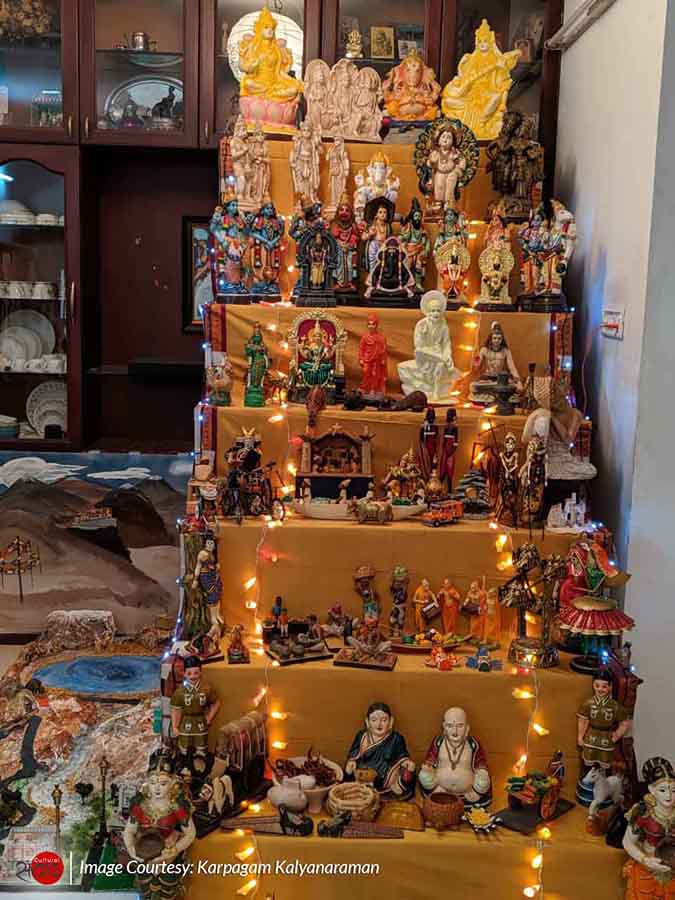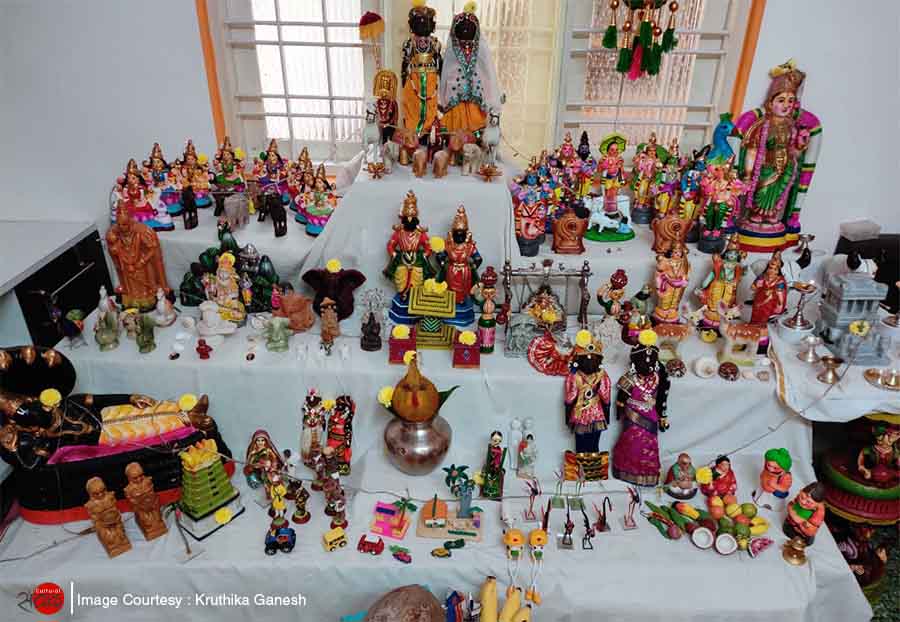All gods (devatas) and human beings stood still like dolls when Adishakti Durga fought with the demonic army of Mahishasura to preserve order in the universe. The Navaratri festival is celebrated all over India commemorating the victory of the Divine Feminine in the war against evil forces. The celebration of Navratri takes distinctive forms defined by local narratives and regional traditions. One such distinctive expression of the festival is the arrangement of kolu or dolls in the Southern states of India.

The significance and stories of dolls during Navaratri
Known as Kolu or Golu (pronounced as गोलु) in Tamil Nadu, Gombe Habba (गोम्बे हब्बा) in Karnataka and Bommala Koluvu (बोम्माला कोलुवु) in Andhra Pradesh, the arrangement of dolls is an integral part of Navaratri celebration in South India. The words Kolu (Golu) in Tamil, Gombe in Kannada and Bomma in Telugu mean dolls.
There is no scriptural evidence for the tradition of temporary arrangement of dolls during the Navaratri festival. It is probably a tradition that transformed from a royal convention into a domestic custom over the last 300 years or so. However, there are a few narratives that try to explain the relevance of dolls in Navaratri.
Some believe that all the creatures of the world stood as still as dolls when the Devi fought the asuras. Contradicting this, some believe that the dolls come to life during the nine nights of the festival and they need to be put back to sleep on the night of Vijayadasham or Dussehra. Others say that the dolls arranged during the festival represent the army of the Devi. Yet another explanation is that the dolls are the source of energy for the Devi in her fight against evil. However, the most popular belief behind the arrangement of kolu is in inviting the Divine Goddess home through the puja of kalasha (कलश – sacred pot) over the nine nights and welcoming sumangalis (married women) and kumaris (prepubescent girls) home who are like all women are the embodiments of the Divine Feminine herself.
Arrangement of the Golu or Gombe – microcosmic representation of the macrocosm
Nine-tiered steps are created to arrange the dolls in a certain hierarchy. The number nine represents the nine forms that Devi Durga is believed to have taken during the nine nights of the war. If one cannot arrange nine steps, an odd number of steps like seven, five or three are arranged (conforming to Indian tradition). The higher steps are preserved for the celestial Gods and Goddesses. The steps in the middle generally have the dolls of the many saints and sages who are revered for the inspiring lives that they led on earth. The lower steps represent the worldly life on Earth which include various stages and activities of human life. The lowest step has a bed of sprouting seeds which are a manifestation of mother nature herself. This hierarchic arrangement of the celestial and terrestrial life is a microcosmic representation of the macrocosm or world order as defined by the popular Hindu belief system.
It is important to remember that the hierarchy is not compulsory. Many arrange dolls based on themes like Ramayana, Mahabharata, Krishna Leela and many more from Indian mythology. Some people just arrange dolls as per their convenience.

Pattada gombe – The Royal Couple of Karnataka
Gombe Habba in Karnataka is characterised by Pattada gombe – a pair of dolls made from wood and dressed as the King and the Queen. This custom of keeping royal dolls is reminiscent of the stately celebration of Navaratri during the times of the Vijayanagara empire. This tradition has been continued by the Mysore Wodeyars. To prevent a break in this tradition, a pair of Pattada gombe is gifted to a newly married daughter by her parents. It is also believed that the Pattada gombe are a married couple who have come to the girl’s maternal home during the Navaratri.
Golu or Gombe Celebrations
The celebrations commence on Ashwayuja Shuddha Prathama which is the first day of Navaratri. At an auspicious time , the leading lady of the house takes a silver pot filled with water and puts five betel leaves and nuts, five turmeric pieces, rice, tur or arhar dal, gold and silver coins in it. She closes its mouth with a coconut collared with mango leaves or betel leaves. The silver pot which is considered to be the manifestation of the Devi herself is wrapped with a silk cloth, bejewelled, adorned with a bindi and a garland of flowers. The festival of Navaratri begins with invoking the Goddess by placing this pot, called kalasha, in the centre of the kolu. In Karnataka, Pattada gombe is placed on one of the lower steps at the same time. For the next nine days, the dolls are not rearranged or touched for they are believed to have come to life now.
For the ten days of the festival, every morning the dolls along with kalasha are worshipped with flowers, prayers and prasada or naivedya (food prepared for the God). In the evening, ladies and kids are invited home to view the dolls. The invited guests take active part in the Gombe Habba by singing songs in praise of God and performing for the Devi. Many households invite women to recite Lalita Sahasranama (ललिता सहस्रनाम,) Soundarya Lahari (सौन्दर्य लहरी), Durga Saptasati (दुर्गा सप्तशती) and such works invoking the Goddess in her infinite forms. The host gives gifts to the invited guests. Sundal (cooked pulses) is offered to the Goddess and then distributed to the guests. Every evening, the puja ends with the aarati of the Devi.
On the day of Vijayadashami , the morning after Navaratri, a final puja is offered to the kolu. The Gombe Habba ends with moving the kalasha to the north and it symbolises that one is bidding goodbye to the Devi. In Karnataka, the Pattada gombe are laid flat symbolising the return of the married daughter to her in-law’s house.
The dolls are put to sleep only to be awakened during next Navaratri. It is important to remember that many of these dolls are passed on from one generation to another and have their own tales to tell.
Watch the story of Mahishurmardini!
Changing dynamics of Gombe Habba or Golu
Over the last many years, while the Gombe Habba continues to be celebrated, its form and manifestation are changing in response to the changing times. We no longer find only idols of gods and goddesses narrating stories from Indian mythology, marriage scenes and farming depicted in the arrangement of the dolls. One can also find representations of freedom fighters in kolu. Band sets, cricket match scenes and laughing Buddhas have also made it to the Kolu tradition. A hostess’ collection can now represent her travel history with dolls from different parts of India and foreign countries finding place on the nine steps.
The sky is the limit to showcase one’s creativity during the Navaratri kolu. Apart from traditional craftsmen, many people themselves make dolls with different materials like terracotta, papier mâché and fabric to suit the themes that they want to present during the festival.
At some point in time, kolu was a preserve of the select few. Over the years, it has made inroads into the homes of one and all. After all, in our fast-paced world, the Gombe Habba gives a new spark to social life and creativity. The entire process of arranging the dolls, inviting guests home, interacting with them, singing and enjoying the festival is an emotion worth experiencing.
Select References
- Simmons,C., Sen, M and Rodrigues, H . (eds) (2018) Nine Nights of the Goddess: The Navaratri Festival in South Asia.New Albany: State University of New York.
- Ikagane, A. (2013). Princely India Re-imagined: A Historical Anthropology of Mysore from 1799 till Present. NewYork: Routledge
Editor’s Note
Golu Dolls – A Celebration of India’s crafts
The Golu festival is an opportunity to celebrate the skill of India’s talented, local craftspeople and showcase the ancient and vibrant tradition of doll and toy making in India. At a time when the Indian market is overflowing with mass manufactured Chinese dolls and toys, the Gombe Habba can serve as an ambassador of the great Indian toy tradition. The bobble headed oscillating Urutu Bommai of Tanjavur (Tamil Nadu), the colourful Channapatna toys (Karnataka) and toys from Kondapalli (Andhra Pradesh) are among the many crafts traditions that are protected and promoted by the Geographical Indication tags of the Ministry of Commerce and Industry. Do remember to add these toys and dolls to your Navaratri collection!


Add comment